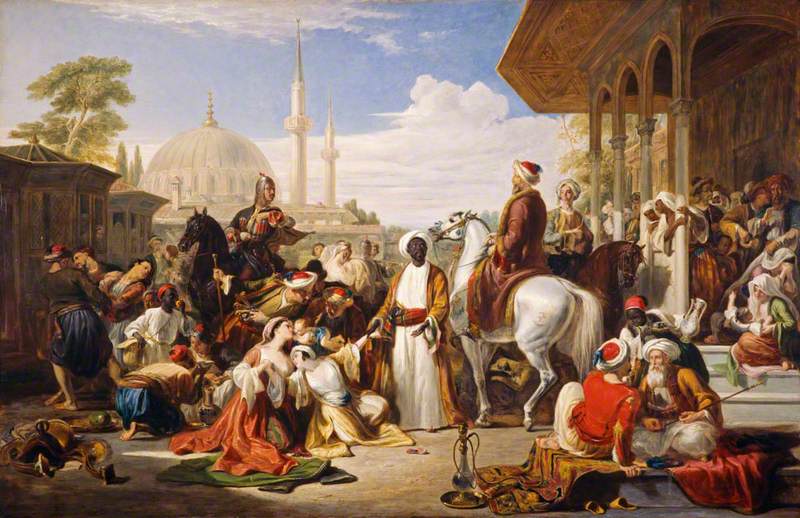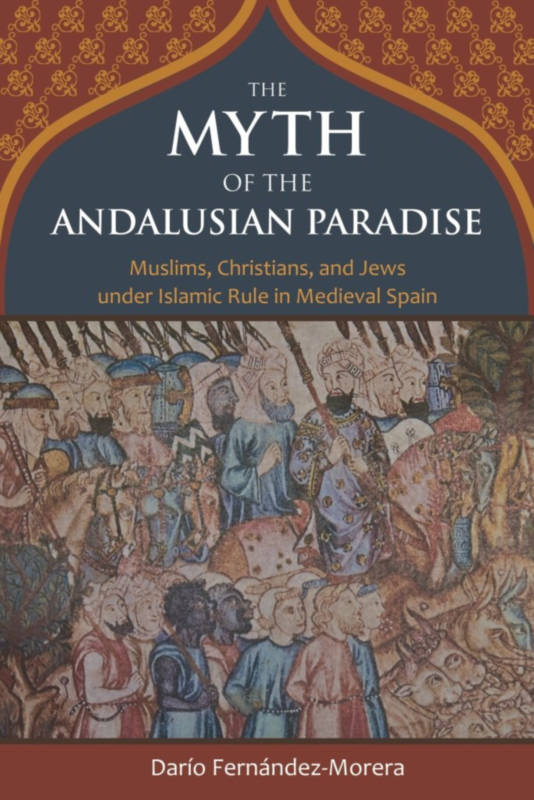This month, we are greatly pleased to present this interview with Darío Fernández-Morera, Associate Professor Emeritus of Northwestern University. He has a B.A. from Stanford, an M.A. from the University of Pennsylvania, and a Ph.D. from Harvard. He has served in the United States National Council for the Humanities.
His research and teaching include, among other subjects, Golden Age and Medieval Spanish literature, culture and history. He has published several books and editions and many articles and reviews in English, Spanish and French on cultural, historical, theoretical and methodological issues in Spain, Europe, Latin America and the United States, including the encounter between Europeans and Amerindians, Cervantes, Garcilaso de la Vega, Fray Luis de León, Inca Garcilaso, Vicente Aleixandre, Islamic Spain, and Modernism.

He has published in, and served as consultant and reader for, History of European Ideas, The European Legacy, Le Figaro Histoire, Symposium, Hispanic Review, The United States National Endowment for the Humanities, Canadian Review of Comparative Literature, Revista Canadiense de Estudios Hispánicos, Comparative Civilizations Review, Comparative Literature Studies, Modern Age, MLN, Bulletin of Hispanic Studies, etc.
Among his publications are The Myth of the Andalusian Paradise: Muslims, Christians and Jews under Islamic Rule in Medieval Spain, now translated into French as Chrétiens, Juifs et Musulmans dans al-Andalus: Mythes et Réalités de l’Espagne Islamique, with a Prologue by French Philosopher, Arabist, Hellenist and Hebraist, Rémi Brague, and into Spanish as El Mito del Paraiso Andalusí: Musulmanes, Cristianos y Judíos bajo el Dominio Islámico en la España Medieval; American Academia and the Survival of Marxist Ideas; The Lyre and the Oaten Flute: Garcilaso and the Pastoral; Fray Luis: Poesía (ed); Europe and its Encounter with the Amerindians (ed.); Cervantes in the English Speaking World (ed. with M. Hanke); Cervantes y su mundo II (ed. with K Reichenberger).
He is the recipient of the 2008 award for Graduate Teaching Excellence from the Northwestern University School of Continuing Studies. He has served as Director of Undergraduate Studies in the Department of Spanish and Portuguese. In 2020 he was honored by the Cervantes Society of America with a Lifetime Membership in the society. He likes animals, especially dogs, plants, and the sea.
He is in conversation with Father Seán Connolly, in which he gives a thorough analysis of a little-known part of history, namely, the plight of European slaves in Islamic lands.
Father Seán Connolly (Fr.SC): What was the ultimate purpose of the early Islamic conquests?
Darío Fernández-Morera (DFM): Applied sharia (fiqh) required that infidels who did not submit peacefully to Islam should be fought and prisoners enslaved. As experts in Islamic Law, such as Felipe Maíllo Salgado (University of Salamanca) explain, and Medieval Islamic treatises and chronicles attest, religion was fundamental. They also make clear that jihad was understood as a struggle to make the world submit, not as some “spiritual” struggle to become “a better person.”
This religious foundation is evident in the answer given by Muslim authorities to the Americans before the “Barbary Wars” (1801-05, 1815), fought by the United States to try to end North African Muslim raids on American and European ships:
We took the liberty to make some inquiries concerning the Grounds of their pretentions to make war upon Nations who had done them no Injury, and observed that we considered all mankind as our friends who had done us no wrong, nor had given us any provocation. The Ambassador [of Tunis] answered us that it was founded on the Laws of their Prophet, that it was written in their Koran, that all nations who should not have acknowledged their authority were sinners, that it was their right and duty to make war upon them wherever they could be found, and to make slaves of all they could take as Prisoners, and that every Musselman [sic] who should be slain in battle was sure to go to Paradise. (Letter of American Commissioners to John Jay, 28 March 1786).
Christians enslaved Muslims, but unlike the case of Islam’s religious texts, the Gospels have no analogous injunctions against non-Christians. Nor was the enslavement of Muslims comparable. As historian Robert C. Davis shows in Christian Slaves, Muslim Masters: White Slavery in the Mediterranean, the Barbary Coast and Italy, 1500-1800, entire European coastal areas and towns were depopulated by Muslim raids. We have no comparable record of depopulation in Muslim lands. As you point out, so vast was the enslavement of Christians, that not one but two monastic orders dedicated themselves to their rescue.
Fr.SC: Detail the dominance of Islamic armies in the Mediterranean region between the 8th and the 19th centuries.
DFM: These attacks, and the enslavement of Christians, should be contextualized within much more encompassing jihads to make the world submit. Islam ended the enclaves of Jews and Christians in Arabia. The larger offensive against Christianity started with the unprovoked jihad against the Christian Greek Roman Empire (misnamed “Byzantine”: its inhabitants called themselves Romans; its enemies called them Romans—Rum, as do Muslim texts–and Europeans called them Greeks to avoid calling them Romans because Europe now had its own “Holy Roman Empire,” started by Charlemagne; nobody called them “Byzantines,” a name invented by a Protestant scholar in the sixteenth century and adopted by academics since).
This jihad wrestled from Christianity the Holy Land, Syria, North Africa, Anatolia (today’s Turkey), Armenia, and Greece. Only Greece and Armenia eventually escaped Islamic control.
This jihad began with the victory over the Christians at Yarmuk (636). It continued until the Christian defeat at Manzikert (1071). Manzikert opened the Christian Anatolian peninsula to the Muslim Turks. It prompted the Greek Roman Emperor Alexius I Comnenos to ask Europe for help. Pope Urban II gave him this help by organizing the First Crusade. Against terrible odds, the crusaders recovered the Holy Land, though only from 1099 to 1291. The Islamic assault against what remained of the Christian Greek Roman Empire culminated with the Fall of Constantinople (1453). Turkish dictator Ataturk, architect of the Armenian Christians’ genocide, changed Constantinople’s name (Κωνσταντινούπολις “the city of [Emperor] Constantine”) to “Istanbul” to erase its Greek and Christian origin.
Islam conquered Zoroastrian Persia (today’s Iran) in the seventh century, ending Zoroastrian rule.
Muslim armies, made up largely of North African Berbers recently forced to convert, crossed the strait named Pillars of Hercules (changed by Muslims to Jebel-al-Tariq, hence Gibraltar, to celebrate their commander Tariq) and conquered three quarters of Christian Spain (711-719). Christians from the North gradually fought back (the Spanish Reconquista), and after their victory at the big battle of Navas de Tolosa (16 July 1212) recovered most of the land, except for the small kingdom of Granada, which fell in 1492.
For centuries, the Spanish Catholic Church celebrated Navas de Tolosa as the day of the Triunfo de la Santa Cruz because Christians saw a cross in the sky, and a banner with the cross, carried by a Canon on horseback before the archbishop of Toledo, Jiménez de Rada (who fought on horseback alongside the Christian soldiers), led the Christians to victory without suffering damage. Navas de Tolosa was the culmination of a Crusade blessed by Pope Innocent III (d. 1216). The celebration has disappeared from the Catholic calendar.
Under Turkish leadership, Islam conquered the Christian Balkans and much of Christian Eastern Europe, and then moved against Central Europe. These attacks culminated with the sieges of Vienna in 1529 (Spanish and German troops saved Vienna) and 1683 (by September 11 Vienna was about to fall, but Vienna and probably Europe were saved on the morning of September 12 by the arrival of Catholic Polish king Jan Sobieski III with his Winged Hussars, who crushed the Turks).
All these attacks produced millions of captives, not counting the centuries of attacks against the coasts and ships of Europe–which reached as far as Iceland–or the massive enslavement of Slavs in Eastern Europe by Islamized Mongols and Tatars. In 846 Arabs even sacked the St. Peter and Paul Basilicas’ treasures and relics (Pope Sergius II fled behind the Aurelian walls; his successor Leo IV built the Vatican walls). Turks sacked Otranto (1480), enslaved thousands, and beheaded 800 who refused to convert (the Martyrs of Otranto); they conquered Cyprus (1570), beheaded the commander of Nicosia, deceived and skinned alive the commander of Famagusta, Marcantonio Bragadino, and enslaved Nicosia and Famagusta’s Greek population. Historian of slavery Olivier Pétré-Grenouilleau (Sciences Po, Paris) estimates that the Islamic enslavement of whites far surpasses the transatlantic trade in black slaves (Les traites négrières).
One victim of the raids in the Mediterranean was Miguel de Cervantes, who was captured and enslaved in Algiers for five years. The Trinitarians ransomed him. He later became a Franciscan Lay Brother, but he asked to be buried at the Convent of the Barefoot Trinitarians in Madrid. Islam impacted Cervantes’s life even earlier: he fought at the crucial Battle of Lepanto (Greek, Naupaktos) on October 7, 1571, off the coast of Greece. At Lepanto, a Christian fleet of Spanish, Venetian, Genoese, Papal, and other Italian ships, organized by Pope Saint Pius V, and commanded by John of Austria, half-brother of King Philip II, defeated a larger Turkish fleet and checked the Islamic advance in the Mediterranean. Fifteen thousand Christian slaves rowing in the Muslim ships were freed. Though ill, Cervantes asked to be placed at the most dangerous part of the ship, and was shot three times. He recovered, but lost the use of his left hand—“for the greater glory of his right one,” as the Spanish saying goes.
October 7th was celebrated by the Catholic Church as the day of Our Lady of Victory, because Saint Pius V instructed all Christian fighters to pray the Rosary before the battle. The day is now called Our Lady of the Rosary. The great banner of the Turkish admiral, decorated with the image of Muhammad’s scimitar, and the name of Allah stitched in gold 29,800 times, was captured and kept for years near the tomb of Saint Pius V at the Church of Santa Maria Maggiore. In 1965 Pope Paul VI gave it to the Turks as a gesture of good will.
Islam attacked China from 651 to 751. Most of China remained unconquered. But the outer regions of the Chinese empire fell. Today’s Kazaks, Uzbeks, Uyghurs, among others, are Muslims. These areas were once Buddhist, Hindu (as was Afghanistan) and even Christian.
Tatars invaded Christian Russia, exacting gold and slaves. After the big Battle of Kulikovo (1380) against the by then Islamized Tatars, Russians gradually reconquered their land.
Islam’s conquest of Hindu lands was brutal. Historian Will Durant wrote: “The Islamic conquest of India is probably the bloodiest story in history” (The Story of Civilization: Our Oriental History). So massive was the export of slaves from India through the mountains, that they were named Hindu Kush, which according to Muslim traveler Ibn Battuta (d. 1368/69) means “Killer of Hindus” in Persian, because of the vast number of Hindus who died from cold and hardships while transported. Pakistan was once Hindu and Buddhist, with some Christians as well.
Such was the impact of Christian slaves on Islamic lands, that many of the Umayyad rulers of Islamic Spain, as the sons of sexual slaves, were blue-eyed and blond or red-haired; and the founder of the “Arabic” Nasrid dynasty of Granada was called al-Hamar, “the Red One,” because of his reddish hair and beard. Tenth century Muslim geographer Ibn Hawqal writes that one of the main exports of Islamic Spain was slaves, and that “most of the white eunuchs of the world come from Spain.” Arabist Celia del Moral observes that in Umayyad al-Andalus the most coveted and therefore expensive sexual slaves were blond and red-haired females from the Northern Christian regions (see, The Myth of the Andalusian Paradise).
Fr.SC: How large scale was the enslavement of sub-Saharan (“black”) Africans during this period?
DFM: Bernard Lugan, Africanist at the University of Lyon III, observes that the slavery of black Africans was initially a trade among black Africans, and that all peoples have practiced slavery, but only the white Europeans abolished it first (Esclavage, l’histoire à l’endroit). This is also noticed by the Benin Professor Abiola Felix Iroko.
Arab merchants were the principal intermediaries in this trade, and they conducted raids to capture black Africans. (See, Ghanan professor John Allenbillah Azumah’s The Legacy of Arab Islam in Africa). Islamic countries did not abolish slavery until recently. Turkey abolished the trade in black (Zanj) and white (Circassian) females in 1908. Kuwait abolished slavery in 1949, Qatar in 1952, Niger in 1960, Saudi Arabia in 1962. In some countries, slavery continues, unofficially.
It was the European colonizers of North Africa in the nineteenth century who not only finally ended the enslaving of white Europeans, but also officially ended the enslavement of sub-Saharan Africans by black Africans and Muslims. This ignored aspect of colonialism is underlined not only by Lugan, but also by Ivorian intellectual Ernst Tigori.
Fr.SC: Would you agree that little attention has been given to this in the teaching of history? Why do you think this is?
DFM: Yes. I want to point out that although traveling on donkeys rather than horses, characteristic of the Trinitarians, may be attributed to humility, another possibility is that in Islamic lands, where the friars went to help the Christian slaves, Christians were forbidden to ride horses. Nor could the Trinitarians have worn their blue and red crosses in Islamic lands. Islamic law considered offensive and even blasphemous and therefore forbade the display of crosses in public, even on the outside walls or on top of churches. They could be shown only inside churches. Moreover, churches could not be allowed in the main parts of a city, only on the outskirts; and they could not be taller or more beautiful than Muslim buildings.
Why all this is not taught in schools, or even discussed amply in academia, is the result of many factors. I will mention only one: “stake-holders” interests. Many academics who write and teach about Islam do not want to present their subject, which they love and is the bread and butter on which they publish, under such unfavorable light; and they will fight tooth and nail anyone who does. Prestigious Western universities and Islamic Studies programs receive large donations from Islamic countries. Academics do not want to jeopardize their careers, and even traveling to Islamic lands, by highlighting the issues examined here; and those who write about slavery do not wish to contextualize their condemnations of black slavery in the Americas by highlighting its centuries of existence before and after 1619 among black Africans and Muslims, or by mentioning the millions of whites enslaved by Islam through the centuries.
The featured images shows, “The Slave Market, Constantinople,” by William Allan, painted in 1838.

